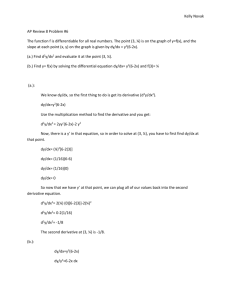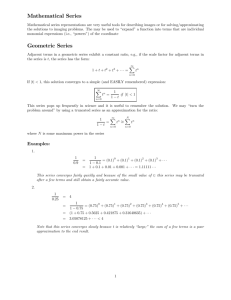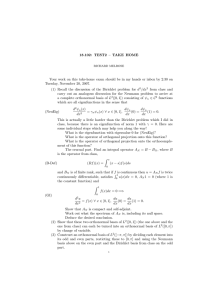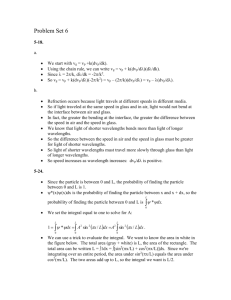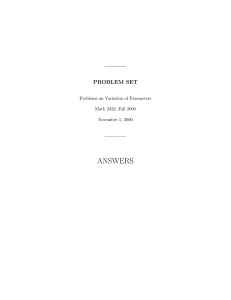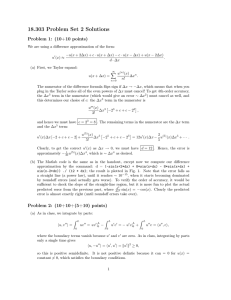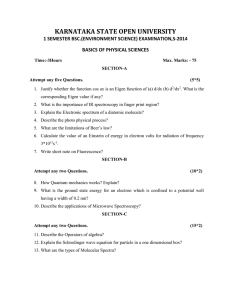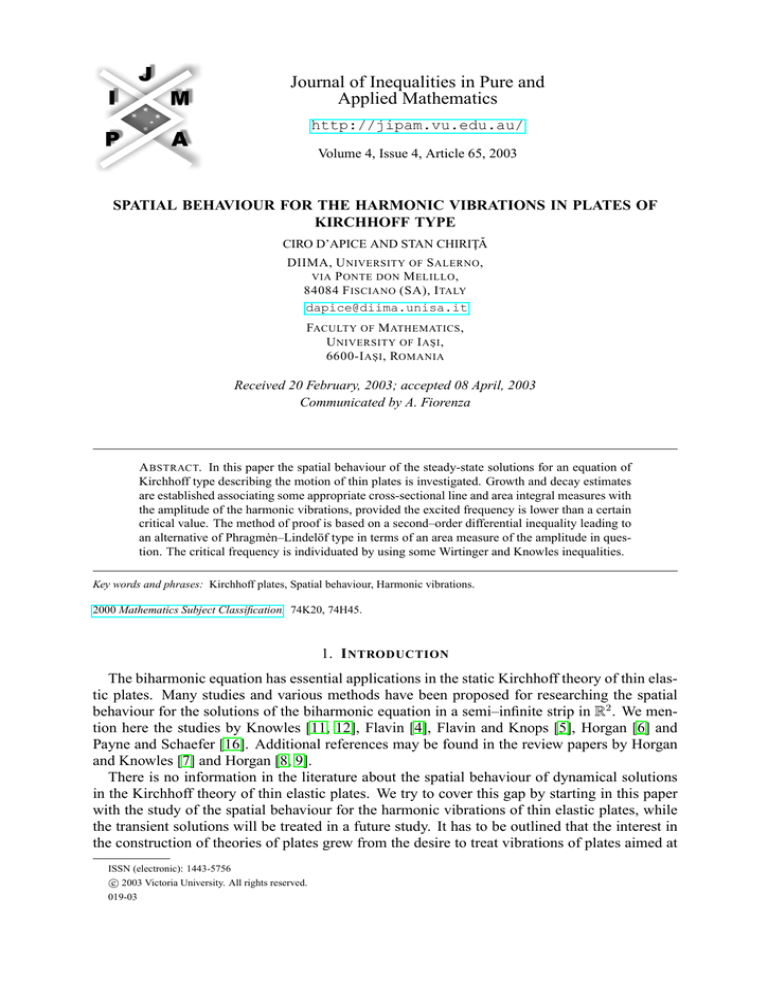
Journal of Inequalities in Pure and
Applied Mathematics
http://jipam.vu.edu.au/
Volume 4, Issue 4, Article 65, 2003
SPATIAL BEHAVIOUR FOR THE HARMONIC VIBRATIONS IN PLATES OF
KIRCHHOFF TYPE
CIRO D’APICE AND STAN CHIRIŢĂ
DIIMA, U NIVERSITY OF S ALERNO ,
VIA P ONTE DON M ELILLO ,
84084 F ISCIANO (SA), I TALY
dapice@diima.unisa.it
FACULTY OF M ATHEMATICS ,
U NIVERSITY OF I A ŞI ,
6600-I A ŞI , ROMANIA
Received 20 February, 2003; accepted 08 April, 2003
Communicated by A. Fiorenza
A BSTRACT. In this paper the spatial behaviour of the steady-state solutions for an equation of
Kirchhoff type describing the motion of thin plates is investigated. Growth and decay estimates
are established associating some appropriate cross-sectional line and area integral measures with
the amplitude of the harmonic vibrations, provided the excited frequency is lower than a certain
critical value. The method of proof is based on a second–order differential inequality leading to
an alternative of Phragmèn–Lindelöf type in terms of an area measure of the amplitude in question. The critical frequency is individuated by using some Wirtinger and Knowles inequalities.
Key words and phrases: Kirchhoff plates, Spatial behaviour, Harmonic vibrations.
2000 Mathematics Subject Classification. 74K20, 74H45.
1. I NTRODUCTION
The biharmonic equation has essential applications in the static Kirchhoff theory of thin elastic plates. Many studies and various methods have been proposed for researching the spatial
behaviour for the solutions of the biharmonic equation in a semi–infinite strip in R2 . We mention here the studies by Knowles [11, 12], Flavin [4], Flavin and Knops [5], Horgan [6] and
Payne and Schaefer [16]. Additional references may be found in the review papers by Horgan
and Knowles [7] and Horgan [8, 9].
There is no information in the literature about the spatial behaviour of dynamical solutions
in the Kirchhoff theory of thin elastic plates. We try to cover this gap by starting in this paper
with the study of the spatial behaviour for the harmonic vibrations of thin elastic plates, while
the transient solutions will be treated in a future study. It has to be outlined that the interest in
the construction of theories of plates grew from the desire to treat vibrations of plates aimed at
ISSN (electronic): 1443-5756
c 2003 Victoria University. All rights reserved.
019-03
2
C IRO D’A PICE AND S TAN C HIRI ŢĂ
deducing the tones of vibrating bells. Thus, in the present paper we consider a semi–infinite
strip for which the lateral boundary is fixed, while its end is subjected to a given harmonic
vibration of a prescribed frequency ω. Our approach is based on a differential equation proposed
by Lagnese and Lions [13] for modelling thin plates and generalising the Kirchhoff equation
of classical thin plates (see, for example, Naghdi [15]). We associate with the amplitude of
the harmonic oscillation an appropriate cross–sectional line–integral measure. We individuate
a critical frequency in the sense that for all vibration frequencies lower than this one, we can
establish a second–order differential inequality giving information upon the spatial behaviour of
the amplitude. In this aim we use some Wirtinger and Knowles inequalities. Then we establish
an alternative of Phragmèn–Lindelöf type: The measure associated with the amplitude of the
oscillation either grows at infinity faster than an increasing exponential or decays toward zero
faster than a decreasing exponential when the distance to the end goes to infinity.
We have to note that some time–dependent problems concerning the biharmonic operator are
considered in the literature, but these are different from those furnished by the theories of plates.
Thus, we mention the papers by Lin [14], Knops and Lupoli [10] and Chiriţă and Ciarletta [1]
in connection with the spatial behaviour of solutions for a fourth–order transformed problem
associated with the slow flow of an incompressible viscous fluid along a semi–infinite strip, and
a paper by Chiriţă and D’Apice [2] concerning the solutions of a fourth–order initial boundary
value problem describing the flow of heat in a non–simple heat conductor.
2. BASIC F ORMULATION
Throughout this paper Greek and Latin subscripts take the values 1, 2, summation is carried
out over repeated indices, x = (x1 , x2 ) is a generic point referred to orthogonal Cartesian
coordinates in R2 . The suffix ”, ρ” denotes ∂x∂ % , that is, the derivative with respect to x% . We
consider a semi–infinite strip S in the plane x1 Ox2 defined by
(2.1)
S = x = (x1 , x2 ) ∈ R2 : 0 < x2 < l, 0 < x1 , l > 0.
In what follows we will consider the following differential equation
(2.2)
α2 ü − β 2 ∆ü + γ 2 ∆∆u = 0,
where ∆u = u,ρρ is the ordinary two–dimensional Laplacian, α, β and γ are positive constants
3
and a superposed dot denotes the time derivative. If we set α2 = %h, β 2 = %h
and γ 2 = D,
12
where % is the mass density, h is the uniform thickness of the plate and D is the flexural rigidity,
then we obtain the approach of plate proposed by Lagnese and Lions [13]. We recall that the
Eh3
flexural rigidity is given by the relation D = 12(1−ν
, where E > 0 is the Young’s modulus
2)
1
and ν is the Poisson’s ratio ranging over −1, 2 . If we set α2 = %h, β 2 = 0 and γ 2 = D in
(2.2), then we obtain the equation occurring in the Kirchhoff theory of thin plates (see [15]).
The reader is referred to [13, Chapter I] for a heuristic derivation of the present plate model.
We further assume that the lateral sides of the plate are fixed, while its end is subjected to an
excited vibration. Then we study the spatial behaviour of the harmonic vibrations of the plate,
that is we study the solution of the equation (2.2) of the type u(x, t) = v(x)eiωt , where ω > 0
is the constant prescribed frequency of the excited vibration on the end of the strip.
More precisely, we consider in the strip S the following boundary value problem P defined
by the equation:
(2.3)
−ω 2 α2 v + β 2 ω 2 ∆v + γ 2 ∆∆v = 0,
J. Inequal. Pure and Appl. Math., 4(4) Art. 65, 2003
in S,
http://jipam.vu.edu.au/
S PATIAL B EHAVIOUR FOR THE H ARMONIC V IBRATIONS IN P LATES OF K IRCHHOFF T YPE
3
the lateral boundary conditions:
v(x1 , 0) = 0, v,2 (x1 , 0) = 0,
(2.4)
v(x1 , l) = 0, v,2 (x1 , l) = 0, x1 ∈ [0, ∞),
and the end conditions:
(2.5)
v(0, x2 ) = g1 (x2 ), v,1 (0, x2 ) = g2 (x2 ), x2 ∈ [0, l],
where g1 and g2 are prescribed continuous differentiable functions.
For future convenience we introduce the following notations:
(2.6)
Dx∗1 x1 = y = (y1 , y2 ) ∈ R2 : 0 ≤ x∗1 < y1 < x1 , 0 < y2 < l ,
(2.7)
Dx1 = y = (y1 , y2 ) ∈ R2 : 0 ≤ x1 < y1 ,
0 < y2 < l .
3. A S ECOND – ORDER D IFFERENTIAL I NEQUALITY
Throughout the following we shall assume that the constant coefficients α, β and γ are strictly
positive. A discussion will be made at the end for the limit case when β tends to zero, that is
for the Kirchhoff model of thin elastic plates.
We start our analysis by establishing a fundamental identity concerning the solution v(x) of
the considered boundary value problem P. This identity will give us an idea on the measure to
be introduced.
Thus, in view of the equation (2.3), we have
h
i
2 2 2
2 2
2
2
(3.1) − ω α v + β ω (vv,1 ),1 − v,1 + (vv,2 ),2 − v,2
h
i
+ γ 2 (vv,111 ),1 − v,1 v,111 + 2 (vv,112 ),2 − 2v,2 v,112 + (vv,222 ),2 − v,2 v,222 = 0
from which we obtain
h
i
2 2
2
2 2
2
2 2
(3.2) − ω α v + β (v,1 + v,2 ) + β ω (vv,1 ),1 + (vv,2 ),2
h
i
+ γ 2 (vv,111 ),1 + 2 (vv,112 ),2 + (vv,222 ),2
h
i
2
2
2
2
− γ (v,1 v,11 ),1 − v,11 + 2 (v,2 v,12 ),1 − 2v,12 + (v,2 v,22 ),2 − v,22 = 0,
and hence, we get
2
2
2
2
2
+ 2v,12
+ v,22
+ v,2
) + γ 2 v,11
(3.3) − ω 2 α2 v 2 + β 2 (v,1
+ β 2 ω 2 vv,1 + γ 2 vv,111 − γ 2 v,1 v,11 − 2γ 2 v,2 v,12 ,1
+ β 2 ω 2 vv,2 + 2γ 2 vv,112 + γ 2 vv,222 − γ 2 v,2 v,22 ,2 = 0.
By integrating the relation (3.3) over [0, l] and by using the lateral boundary conditions described in (2.4), we get the following identity
Z l
Z l
2 2
2
2
2
2
2
2 2
2
v,11
+ 2v,12
+ v,22
dx2
α v + β (v,1 + v,2 ) dx2 + γ
(3.4) − ω
0
0
Z l
1 2 2 2
2
2
2
+
β ω v + γ (vv,11 − v,1 − v,2 )
dx2 = 0.
2
0
,11
Before deriving our growth and decay estimates, we proceed to establish a second–order
differential inequality in terms of a cross–sectional line integral measure which is fundamental
J. Inequal. Pure and Appl. Math., 4(4) Art. 65, 2003
http://jipam.vu.edu.au/
4
C IRO D’A PICE AND S TAN C HIRI ŢĂ
in our analysis on the spatial behaviour. In this aim we associate with the solution v(x) of the
considered boundary value problem P the following cross–sectional line integral measure
Z l
1 2 2 2
2
2 2
(3.5)
I(x1 ) =
γ (v,1 + v,2 − vv,11 ) − β ω v dx2 , x1 > 0,
2
0
so that the identity (3.4) furnishes
Z l
Z l
2 2
00
2
2
2
2
2
2
2
v,11 + 2v,12 + v,22 dx2 − ω
α v + β 2 (v,1
+ v,2
) dx2 , x1 > 0.
(3.6) I (x1 ) = γ
0
0
Further, we use the lateral boundary conditions described by (2.4) in order to write the following Wirtinger type inequalities
Z
Z l
l2 l 2
2
v dx2 ,
(3.7)
v,1 dx2 ≤ 2
π 0 ,12
0
l
Z
2
v,2
dx2
(3.8)
0
Z
(3.9)
0
l
l2
≤ 2
4π
l
Z
2
v,22
dx2 ,
0
4 4 Z l
2
l
v dx2 ≤
v 2 dx2 .
3 π 4 0 ,22
2
On the other hand, by using the same lateral boundary conditions in the inequality established
by Knowles [12] (see the Appendix), we deduce that
Z l
Z l
β2
2 2
2 2
2
(3.10)
β v,2 + α v dx2 ≤
v,22
dx2 ,
Λ(α, β) 0
0
where Λ(α, β) is defined by
Λ(α, β) = λ
(3.11)
α2
β2
,
and λ(t) is as defined in the Appendix. Therefore, we have
(3.12)
Λ(α, β) =
4 r4 (τ )
,
l2 τ + r2 (τ )
τ=
α2 l 2
,
4β 2
and r(τ ) is the smallest positive root of the equation
r
r
τ
τ
(3.13)
tan r = −
tanh r
,
τ + r2
τ + r2
τ ≥ 0.
Thus, on the basis of the relations (3.7) and (3.10), we can conclude that
Z l
Z
2 2
γ2 l 2
2 2
2
2
(3.14)
α v + β (v,1 + v,2 ) dx2 ≤ 2
(2v,12 + v,22
)dx2 ,
ω
0
m 0
where ωm = ωm (α, β, γ) is defined by
(3.15)
1
1
= 2 max
2
ωm
γ
l2 β 2
β2
,
2π 2 Λ(α, β)
.
By taking into account the relations (3.6) and (3.14), we obtain the following estimate
Z l
ω2
00
2
2
2
2
(3.16)
I (x1 ) ≥ γ 1 − 2
v,11
+ 2v,12
+ v,22
dx2 , x1 > 0.
ωm
0
J. Inequal. Pure and Appl. Math., 4(4) Art. 65, 2003
http://jipam.vu.edu.au/
S PATIAL B EHAVIOUR FOR THE H ARMONIC V IBRATIONS IN P LATES OF K IRCHHOFF T YPE
5
Throughout in this paper we shall assume that the prescribed frequency ω of the excited
vibration is lower than the critical value ωm defined by the relation (3.15), that is we assume
that
0 < ω < ωm .
(3.17)
This assumption then implies that
I 00 (x1 ) ≥ 0 for all x1 > 0.
(3.18)
We proceed now to estimate the term I(x1 ) as defined by the relation (3.5). We first note that
Z l
Z
1 2 2 l 2
2
2
|I(x1 )| ≤ γ (v,1 + v,2 − vv,11 )dx2 + β ω
v dx2 .
2
0
0
2
(3.19)
Further, we use an idea of Payne and Schaefer [16] for estimating the first integral in (3.19).
Thus, by means of the Cauchy–Schwarz and arithmetic–geometric mean inequalities and by
using the Wirtinger type inequalities (3.7), (3.8) and (3.9), we deduce
Z l
2
2
(v,1 + v,2 − vv,11 )dx2 (3.20)
0
Z
≤
l
2
2
(v,1
+ v,2
)dx2 +
Z
0
l
v 2 dx2
0
l
Z
2
v,11
dx2
21
0
Z l
12 )
Z l
1 2
8
2
2
+ v,22 dx2 +
v,22 dx2
v,11 dx2
2
9
0
0
0
Z l
l2
4 2
1 4ε
2
2
v + 2v,12 +
+
v,22 dx2 ,
≤ 2
2π 0 9ε ,11
2
9
l2
≤ 2
2π
(Z l
2
2v,12
for some positive constant ε. We now choose ε = 49 and note that 12 + 4ε
= 113
< 1. With this
9
162
choice the relations (3.19) and (3.20) give
Z l
Z
1 2 2 l 2
2
2
2
2
2
(3.21)
|I(x1 )| ≤ m0
γ v,11 + 2v,12 + v,22 dx2 + β ω
v dx2 ,
2
0
0
where
l2
(3.22)
m20 = 2 .
2π
On the basis of the inequality (3.9), we further deduce that
Z l
2
2
2
2
(3.23)
|I(x1 )| ≤ m̃0
γ 2 v,11
+ 2v,12
+ v,22
dx2 , x1 > 0,
0
where
(3.24)
m̃20
=
m20
β 2ω2
+
2γ 2
4 4
2
l
.
3 π4
Finally, the relations (3.16) and (3.23) lead to the following estimate
(3.25)
00
m̃2 |I(x1 )| ≤ I (x1 ), x1 > 0,
where m̃ is defined by
(3.26)
J. Inequal. Pure and Appl. Math., 4(4) Art. 65, 2003
1
m̃ = 2
m̃0
2
ω2
1− 2
ωm
.
http://jipam.vu.edu.au/
6
C IRO D’A PICE AND S TAN C HIRI ŢĂ
Consequently, we have established the following two second–order differential inequalities
00
(3.27)
I (x1 ) + m̃2 I(x1 ) ≥ 0,
(3.28)
I (x1 ) − m̃2 I(x1 ) ≥ 0,
00
which will be used in the derivation of the alternatives that we will consider, always under the
condition that (3.17) holds true.
4. S PATIAL B EHAVIOUR
In this section we will analyse the consequences of the second–order differential inequalities
on the spatial behaviour of the measure I(x1 ). In fact, in view of the relation (3.18), it follows
that we have only the two cases:
0
i) there exist a value z1 ∈ [0, ∞) such that I (z1 ) > 0,
0
ii) I (x1 ) ≤ 0, ∀ x1 ∈ [0, ∞).
00
4.1. Discussion of the Case i). Since we have I (x1 ) ≥ 0 for all x1 > 0, we deduce that
I(x1 ) ≥ I(z1 ) + I 0 (z1 )(x1 − z1 ) for all x1 ≥ z1 ,
(4.1)
and hence it follows that, at least for sufficiently large values of x1 , I(x1 ) must become strictly
positive. That means there exists a value z2 ∈ [z1 , ∞) so that I(z2 ) > 0. Because we have
I 0 (x1 ) ≥ I 0 (z2 ) > 0 for all x1 ∈ [z2 , ∞), it results that I(x1 ) is a non–decreasing function on
[z2 , ∞) and therefore, we have I(x1 ) ≥ I(z2 ) > 0 for all x1 ∈ [z2 , ∞). Further, the relation
(3.25) implies
io
d n −m̃x1 h 0
(4.2)
e
I (x1 ) + m̃I(x1 ) ≥ 0, x1 ∈ [z2 , ∞),
dx1
io
d n m̃x1 h 0
e
I (x1 ) − m̃I(x1 ) ≥ 0, x1 ∈ [z2 , ∞).
dx1
(4.3)
By an integration over [z2 , x1 ], x1 > z2 , the relations (4.2) and (4.3) give
h 0
i
0
(4.4)
I (x1 ) + m̃I(x1 ) ≥ I (z2 ) + m̃I(z2 ) em̃(x1− z2 ) , x1 ≥ z2 ,
h 0
i
0
I (x1 ) − m̃I(x1 ) ≥ I (z2 ) − m̃I(z2 ) e−m̃(x1− z2 ) , x1 ≥ z2 ,
(4.5)
and therefore, we get
(4.6)
0
0
I (x1 ) ≥ I (z2 ) cosh[m̃(x1 − z2 )] + m̃I(z2 ) sinh[m̃(x1 − z2 )], x1 ≥ z2 .
On the other hand, by taking into account the notation (2.6) and by integrating the relation
(3.6) over [z2 , x1 ], x1 > z2 , we obtain
Z
0
0
2
2
2
2
(4.7)
I (x1 ) = I (z2 ) + γ
v,11
+ 2v,12
+ v,22
da
Dz2 x1
−ω
2
Z
2 2
2
2
α v + β 2 (v,1
+ v,2
) da.
Dz2 x1
J. Inequal. Pure and Appl. Math., 4(4) Art. 65, 2003
http://jipam.vu.edu.au/
S PATIAL B EHAVIOUR FOR THE H ARMONIC V IBRATIONS IN P LATES OF K IRCHHOFF T YPE
7
Consequently, the relations (4.6) and (4.7) give
Z
2
2
2
2
da
+ v,22
+ 2v,12
v,11
(4.8) γ
Dz2 x1
≥ω
2
Z
2 2
0
2
2
α v + β 2 (v,1
+ v,2
) da + I (z2 ) {cosh [m̃(x1 − z2 )] − 1}
Dz2 x1
+ m̃I(z2 ) sinh [m̃(x1 − z2 )] , x1 > z2 ,
and hence
(
(4.9)
lim
x1 →∞
e−m̃x1
)
Z
2
2
2
γ 2 v,11
+ 2v,12
+ v,22
da
Dz2 x1
h 0
i
1
≥ e−m̃z2 I (z2 ) + m̃I(z2 ) > 0.
2
Thus, we can conclude that, within the class of amplitudes v(x) for which there exists z1 ≥ 0
so that I 0 (z1 ) > 0, the following measure
Z
2
2
2
(4.10)
E(x1 ) =
v,11
+ 2v,12
+ v,22
da, Dx∗1 = [0, x1 ] × [0, l],
Dx∗1
grows to infinity faster than the exponential em̃x1 when x1 goes to infinity.
4.2. Discussion of the Case ii). In this case we have
(4.11)
I 0 (x1 ) ≤ 0 for all x1 ∈ [0, ∞),
and therefore, I(x1 ) is a non–increasing function on [0, ∞). We prove then that
(4.12)
I(x1 ) ≥ 0 for all x1 ∈ [0, ∞).
To verify this relation we consider some z0 arbitrary fixed in [0, ∞) and note that, by means of
the relation (4.11), we have
(4.13)
I(x1 ) ≤ I(z0 ) for all x1 ≥ z0 .
On the other hand, the relation (3.27), when integrated over [z0 , x1 ], x1 > z0 , gives
0
(4.14)
0
0 ≤ I (z0 ) − I (x1 )
Z x1
2
≤ m̃
I(ξ)dξ
z0
Z x1
2
≤ m̃
I(z0 )dξ = m̃2 I(z0 )(x1 − z0 ),
z0
and hence it results that I(z0 ) ≥ 0. This proves that the relation (4.12) holds true.
Now, on the basis of the relation (4.12) and by using the relations (3.5) and (3.20) (with the
appropriate choice for ε), we deduce that
(4.15)
0 ≤ I(x1 )
Z
Z l
1 2 2 l 2
2
2
2
v dx2
=γ
(v,1 + v,2 − vv,11 )dx2 − β ω
2
0
0
Z h
2
2
2
≤γ
(v,1
+ v,2
− vv,11 )dx2
0
Z l
2
2
2
2
≤ m0
γ 2 (v,11
+ 2v,12
+ v,22
)dx2 ,
0
J. Inequal. Pure and Appl. Math., 4(4) Art. 65, 2003
http://jipam.vu.edu.au/
8
C IRO D’A PICE AND S TAN C HIRI ŢĂ
and hence, by using the inequality (3.16), we obtain
I 00 (x1 ) − m2 I(x1 ) ≥ 0, x1 > 0,
(4.16)
where
2π 2
ω2
1
ω2
(4.17)
m̄ = 2 1 − 2 = 2 1 − 2 .
m0
ωm
l
ωm
To determinate the consequences of the second–order differential inequality (4.16), we write it
in the following form
d mx1 0
(4.18)
e
[I (x1 ) − mI(x1 )] ≥ 0,
dx1
and then integrate it over [0, x1 ] to obtain
2
−I 0 (x1 ) + mI(x1 ) ≤ e−mx1 [−I 0 (0) + mI(0)] , x1 ≥ 0.
(4.19)
On the basis of this relation, we further can note that a successive integration over [x1 , ∞) of
the relation (3.16) gives
Z
ω2
2
2
2
0
(4.20)
−I (x1 ) ≥ 1 − 2
γ 2 v,11
+ 2v,12
+ v,22
da, x1 ≥ 0,
ωm
Dx1
and
I(x1 ) ≥
(4.21)
ω2
1− 2
ωm
Z
∞
x1
Z
2
2
2
γ 2 v,11
+ 2v,12
+ v,22
daξ dξ, x1 ≥ 0.
Dξ
Further, by using the estimate (4.19), from the relations (4.20) and (4.21), we deduce the following spatial estimates
Z
1
2
2
2
[−I 0 (0) + mI(0)] e−mx1 , x1 ≥ 0,
(4.22)
v,11
+ 2v,12
+ v,22
da ≤
2
ω
Dx1
γ 2 1 − ω2
m
and
Z
∞
Z
(4.23)
x1
2
2
2
v,11
+ 2v,12
+ v,22
daξ dξ
Dξ
− 32
ω2
l
≤ √
1− 2
[−I 0 (0) + mI(0)] e−mx1 , x1 ≥ 0.
2
ωm
π 2γ
Thus, we can conclude that in the class of amplitudes v(x) for which I 0 (x1 ) ≤ 0 for all
x1 ≥ 0 the measure
Z
2
2
2
)da
(4.24)
F(x1 ) =
(v,11
+ 2v,12
+ v,22
Dx1
decays toward zero faster than the exponential e−mx1 when x1 goes to infinity.
5. C ONCLUSION
On the basis of the above analysis we can conclude that, for an amplitude v(x), solution of
the boundary value problem P, we have the following alternative of Phragmèn-Lindelöf type:
either the measure E(x1 ) grows toward infinity faster than the exponential em̃x1 when x1 goes
to infinity and then the energy
Z
2
2
2
(5.1)
U(v) = (v,11
+ 2v,12
+ v,22
)da
S
J. Inequal. Pure and Appl. Math., 4(4) Art. 65, 2003
http://jipam.vu.edu.au/
S PATIAL B EHAVIOUR FOR THE H ARMONIC V IBRATIONS IN P LATES OF K IRCHHOFF T YPE
9
is unbounded, or the energy U(v) is bounded and then the measure F(x1 ) decays toward zero
faster than the exponential e−m̄x1 , provided the excited frequency ω is lower than the critical
value ωm defined by the relation (3.15).
6. T HE K IRCHHOFF T HEORY OF T HIN P LATES
We consider here as a limit case the Kirchhoff theory of thin elastic plates, that is the case
when β tends to zero. It can be seen from the relation (A7) that r(τ ) decreases monotonically
with increasing τ , and that
(6.1)
r(0+ ) = lim+ r(τ ) = π, r(∞) = lim r(τ ) = r0 ,
τ →∞
τ →0
where r0 = 2.365 is the smallest positive root of the equation
tan r = − tanh r.
(6.2)
It follows then from the relations (A7) and (6.1) that λ(t) is a decreasing function with respect
to t, and that
4
4π 2
2r0
+
(6.3)
λ(0 ) = lim+ λ(t) = 2 , lim tλ(t) =
.
t→∞
t→0
l
l
In view of the relation (3.11) and by using the relation (6.3) it follows that
4
Λ(α, β)
1 2r0
(6.4)
lim
= 2
,
β→0
β2
α
l
and hence the relation (3.15) furnishes that
4
4
γ 2 2r0
Eh2
4.73
2
(6.5)
ωm = 2
=
.
α
l
12(1 − ν 2 )%
l
To this end we recall the critical value established by Ciarletta [3] for the model of thin plates
with transverse shear deformation
∗2
ωm
(6.6)
h2 π 4
µ
=
,
2
2
4l %(h π 2 + l2 )
that is
(6.7)
∗2
ωm
Eh2 π 4
1
=
.
2
8(1 + ν)% l
1 + hl2 π 2
Therefore, we have
(6.8)
Φ=
and because we have h l and
1
2
(6.9)
∗2
ωm
1−ν
= 0.29191
,
2
2
ωm
1 + hl2 π 2
< 1 − ν < 2, it results that
Φ < 0.58382.
This leads to the idea that for the Kirchhoff theory of thin plates we have an interval of frequencies larger than that of the Reissner–Mindlin model for which we can establish the spatial
behaviour of the amplitudes.
J. Inequal. Pure and Appl. Math., 4(4) Art. 65, 2003
http://jipam.vu.edu.au/
10
C IRO D’A PICE AND S TAN C HIRI ŢĂ
7. A PPENDIX
In [12] Knowles has established the following result: for any function u ∈ C02 ([0, l]) and for
any real number t ≥ 0, we have
Z t
Z l
2
(A1)
u,22 dx2 ≥ λ(t) (u2,2 + tu2 )dx2 ,
0
0
where
(A2)
λ(t) =
4 r4 (τ )
,
l2 τ + r2 (τ )
τ=
tl2
,
4
and r(τ ) is the smallest positive root of the equation
r
r
τ
τ
(A3)
tan r = −
tanh r
, τ ≥ 0.
τ + r2
τ + r2
Moreover, λ(t) is the largest possible constant in (A1) in the sense that if, for a given t, λ(t) is
replaced by a smaller constant, there is a u ∈ C02 ([0, l]) for which (A1) fails to hold.
The proof of the result stated above is based on the fact that the variational problem of finding
the extremals in C02 ([0, l]) of the ratio
Rl 2
u,22 dx2
(A4)
J {u} = R l 0
,
2
2 )dx
(u
+
tu
2
,2
0
for fixed t ≥ 0 leads formally to the eigenvalue problem
(A5)
u,2222 + λu,22 − λtu = 0 on [0, l],
(A6)
u(0) = u,2 (0) = u(l) = u,2 (l) = 0.
It can be proved that the eigenvalues λ are given by
4 r4 (τ )
, τ=
l2 τ + r2 (τ )
where r is a positive root of either of the equations
r
r
τ + r2
tanh r
(A8)
tan r =
τ
τ
(A7)
(A9)
λ(t) =
r
tan r = −
tl2
,
4
τ
+ r2
,
r
τ
τ
tanh r
.
τ + r2
τ + r2
It is shown that the smallest eigenvalue λ(t) corresponds to the smallest positive root r(τ ) of the
equation (A9) and the corresponding eigenfunction has no zero in (0, l) and realize the absolute
minimum of J {u} on C02 ([0, l]).
R EFERENCES
[1] S. CHIRIŢĂ AND M. CIARLETTA, Spatial behaviour of solutions in the plane Stokes flow, J.
Math. Anal. and Applic., 277 (2003), 571–588.
[2] S. CHIRIŢĂ AND C. D’APICE, On the spatial behaviour for the flow of heat in a non–simple heat
conductor, An. St. Univ. Iaşi, Matematica, XLVIII (2002), 75–100.
[3] M. CIARLETTA, On the spatial behaviour of the transient and steady–state solutions in thin plates
with transverse shear deformation, Int. J. Engng. Sci., 40 (2002), 485–498.
J. Inequal. Pure and Appl. Math., 4(4) Art. 65, 2003
http://jipam.vu.edu.au/
S PATIAL B EHAVIOUR
FOR THE
H ARMONIC V IBRATIONS IN P LATES OF K IRCHHOFF T YPE
11
[4] J.N. FLAVIN, On Knowles’ version of Saint-Venant’s principle in two–dimensional elastostatics,
Arch. Rational Mech. Anal., 53 (1974), 366–375.
[5] J.N. FLAVIN AND R.J. KNOPS, Some convexity considerations for a two–dimensional traction
problem, J. Appl. Math. and Phys. (ZAMP), 39 (1988), 166–176.
[6] C.O. HORGAN, Decay estimates for the biharmonic equation with applications to Saint–Venant
principles in plane elasticity and Stokes flow, Quart. Appl. Math., 47 (1989), 147–157.
[7] C.O. HORGAN AND J.K. KNOWLES, Recent developments concerning Saint-Venant’s principle,
in Advances in Applied Mechanics, T.Y. Wu and J.W. Hutchinson (eds), vol. 23 (1983), Academic
Press, New York, pp. 179-269.
[8] C.O. HORGAN, Recent developments concerning Saint–Venant’s principle: An update, Appl.
Mech. Rev., 42 (1989), 295–303.
[9] C.O. HORGAN, Recent developments concerning Saint–Venant’s principle: A second update,
Appl. Mech. Rev., 49 (1996), S101–S111.
[10] R.J. KNOPS AND C. LUPOLI, End effects for plane Stokes flow along a semi–infinite strip, J.
Appl. Math. and Phys. (ZAMP), 48 (1997), 905–920.
[11] J.K. KNOWLES, On Saint–Venant’s principle in the two–dimensional linear theory of elasticity,
Arch. Rational Mech. Anal., 21 (1966), 1–22.
[12] J.K. KNOWLES, An energy estimate for the biharmonic equation and its application to Saint–
Venant’s principle in plane elastostatics, Indian J. Pure Appl. Math., 14 (1983), 791–805.
[13] J.E. LAGNESE AND J.-L. LIONS, Modelling, Analysis and Control of Thin Plates, In Collection
RMA, Vol. 6, Masson, Paris, 1988.
[14] C. LIN, Spatial decay estimates and energy bounds for the Stokes flow equation, Stability and Appl.
Anal. of Continuous Media, 2 (1992), 249–264.
[15] P.M. NAGHDI, The theory of shells and plates, in Encyclopedia of Physics, vol. VIa/3, Mechanics
of Solids II, (C.A. Truesdell, ed.), Springer–Verlag, Berlin, 1972, pp. 425–640.
[16] L.E. PAYNE AND P.W. SCHAEFER, Some Phragmén–Lindelöf type results for the biharmonic
equation, J. Appl. Math. and Phys. (ZAMP), 45 (1994), 414–432.
J. Inequal. Pure and Appl. Math., 4(4) Art. 65, 2003
http://jipam.vu.edu.au/


